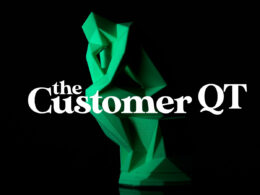Editor’s Note: Customer Care, Customer Love, Customer Loyalty – a lot of hard work goes into scaling those mountains. Because so much of the engagement in those realms happens online, maybe it’s time to start considering customers’ digital wellbeing? Maybe it’s time to consider a more holistic approach to those relationships?
An important implication of digital marketing is the sheer volume of content it builds and the frequency at which it is delivered. This could lead to a sense of digital overwhelm, even necessitating a detox in some cases. In this article, we discuss:
- Recent trends and metrics on digital consumption
- Tips to support digital wellbeing for customers
- Examples of brands using digital wellbeing in their marketing campaigns
Today, a company’s online presence is a big part of its overall marketing strategy. From customer emails and social media to website content and chat-based support, a significant portion of marketing communications now happens online. However, this has an important downside.
Research reveals that customers are now spending hundreds of hours every month on digital platforms, often reaching unhealthy levels of digital consumption. For example, the 2019 Sign of the Times survey by Behaviour & Attitudes surveyed 1000 Irish adults to reveal that three out of four individuals are using the internet every day. The number of people logging in to Facebook, WhatsApp, Instagram, Viber, and Snapchat has all increased.
This is just one instance of how digital overload is impacting consumers. It’s no surprise, therefore, that users are increasingly interested in initiatives like digital detox that encourage positive tech habits.
So how can you, as a marketer, help consumers reach their digital wellbeing goals in 2020? Is it possible to strengthen your online brand without overwhelming users with content on multiple platforms? We think the answer is a definitive YES.
Tips to Support Digital Wellbeing Through Smarter Marketing Strategies
Digital wellbeing is now a key concern for consumers across the globe. The issue has become so severe that tech-giants such as Google and Apple are doubling down on digital wellbeing. In 2018, Google launched several updates on its Android OS to help users stay aware of their digital consumption habits. Apple, too, lets users monitor how much time they spend on social media, productivity, creativity, and other categories.
Google even has a course for marketers and other professionals looking to know more about digital wellbeing. Let’s look at a few tips that can help you make this issue a cornerstone of your marketing strategy.
1. Leverage values-driven content to stand out
A major reason for digital overwhelm is the sheer volume of content available. Consumers either scroll through without really paying attention, or simply log off in an attempt at digital detox.
That’s why brands need to strike a balance when designing content. It should make consumers pause and take a closer look at your messaging. At the same time, they must also feel like the message was worth the time that they spent looking at the screen.
We recommend leveraging values-driven content that strikes an emotional chord with consumers – as opposed to ephemeral viral videos, clickbait, etc. Videos depicting the problems of child-rearing with empathy, to promote a diaper brand, can be targeted to young parents, instead of simply offering a discount via email.
2. Integrate your offline and online channels to drive a seamless experience
A robust offline footprint can help to maintain brand relevance even when its customers undertake a detox for their digital wellbeing. To achieve this, you need a widespread omnichannel game plan, as well as a keen focus on offline marketing. Let’s say your brand is only limited to Instagram – when a user logs out, their interaction with the brand will peter down in tandem.
It is advisable to build a consistent omnichannel presence with regular – but not over-frequent – content shared on every major social and digital platform. Next, this must be reinforced by your offline footprint. If a brick-and-mortar store isn’t feasible, consider simple techniques like a weekend pop-up, kiosks at a local event, or a TV spot.
This will also dissociate your brand from a customer’s digital consumption patterns and make its core value proposition even clearer.
3. Reimagine your website from a digital wellbeing perspective
The website is often the first and most vital touchpoint for a customer looking up your brand. Make sure that digital wellbeing comes across as a brand priority during their visit.
An excellent way to achieve this is via a chatbot that explains data privacy laws and how customers can take ownership. Make it easy for them to control their cookie preference, and avoid asking for consent without an option to configure the preferences.
Other strategies to mitigate digital overwhelm on your website could be to reduce the number of ads/pop-ups, ensuring there is plenty of white space, and a dedicated page for videos so that the user can choose to navigate to that section or stay away from it. Small design elements like these are integral to maintaining the digital wellbeing of your website visitors and prospective customers.
Does Digital Wellbeing Imply Sacrificing Online Relevance?
The short answer is NO, not at all. In fact, several companies have used this concept to reposition and strengthen their brand identity.
The Meantime Brewing Company launched a campaign called “make time for it” when it took six whole weeks to brew a batch of beer. During that time, it partnered with a renowned furniture designer, Lazerian, to build a customized bar stool.
The takeaway was that customers need to make time for creativity and self-fulfillment, even in today’s fast-evolving digital era.
Meantime Brewing Company’s Video Showing the Value of Time
Another interesting example was the “phone stack” campaign by KFC. The fast-food company launched an app that turned avoiding smartphone usage into a game.
As long as phones were stacked together, the app would record minutes and earn points for the customer. Not only did the campaign drive home the importance of digital wellbeing, but it also encouraged customers to buy KFC products!
KFC’s Phone Stack Campaign
In 2020, digital wellbeing is on top of everybody’s mind. In 2019, Google found that one in three Americans took steps to improve their digital wellbeing in the last one year. This includes monitoring online activity, paying attention to data privacy, and cutting down on screen time.
Marketers must factor in this concern when designing campaigns, striking a careful balance between eye-catching content and healthy media consumption.
Is digital wellbeing a priority for your brand in 2020? Why, or why not? Tell us on LinkedIn, Facebook, or Twitter. We would love to know what you think!
Chiradeep BasuMallick is a contributor to Ziff Davis B2B. He is a content marketing professional with 8 Years+ experience in corporate communications, marketing content, brand management, and advertising.
This article originally appeared in MarTechAdvisor. Photo by Adam Jang on Unsplash.













